
Sterling is a town in Windham County, Connecticut, United States. The population was 3,578 at the 2020 census.
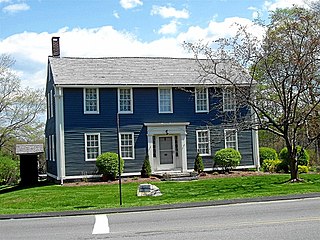
The William Williams House is a historic house in Lebanon, Connecticut at the junction of Connecticut Routes 87 and 207, a National Historic Landmark. It is significant as the residence of Founding Father William Williams (1731–1811), who was a delegate from Connecticut Colony to the Continental Congress and a signer of the Declaration of Independence. Williams lived here from 1755 until his death, and it is a well-preserved and little-altered colonial-era house.
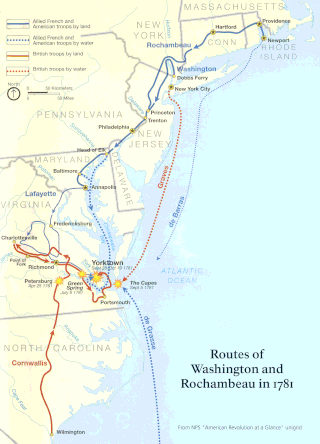
The Washington–Rochambeau Revolutionary Route is a 680-mile (1,090 km) series of roads used in 1781 by the Continental Army under the command of George Washington and the Expédition Particulière under the command of Jean-Baptiste de Rochambeau during their 14-week march from Newport, Rhode Island to Yorktown, Virginia. 4,000 French and 3,000 American soldiers began the march.

The Waterman Tavern is a historic house and tavern at 283 Maple Valley Road, near Whaley's Hollow in Coventry, Rhode Island. The 2+1⁄2-story wood-frame house was built before 1747 by John Waterman, who was licensed to operate a tavern on the premises in that year. It is five bays wide with a central chimney. The site was advantageously located on the main road between Providence and Plainfield, Connecticut. The tavern was a center of civic discourse, and town meetings were regularly held there until 1835.
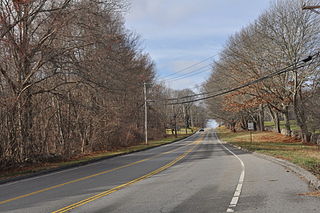
The March Route of Rochambeau's Army: Scotland Road is a historic road section in Windham, Connecticut. Extending along Scotland Road, from itsintersection with Back Rd. to 80 Scotland Road in, it is an evocative portion of the historic march route of the French Army under the Comte de Rochambeau in 1781 and 1782 during the American Revolutionary War. The troops camped beside the road within this segment in 1782. It was listed on the National Register of Historic Places in 2003.
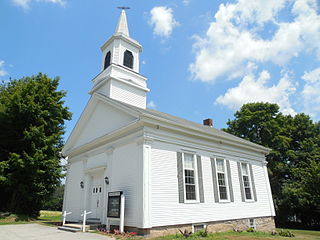
The Sterling Hill Historic District encompasses a well-preserved early 19th-century rural village center on western edge of the town of Sterling, Connecticut. Centered at the junction of Plainfield Pike and Sterling Hill Road, it consists of a cluster of 19th and early 19th-century houses, and a church. Unlike other period villages, it has largely been unaffected by later development. It was listed on the National Register of Historic Places in 1986.

The Forty-Seventh Camp of Rochambeau's Army is a historic military camp site in Windham, Connecticut, located along Scotland Road a short way east of Windham Center. It was the site of a French Army camp in November 1782 on their march from the victory at Yorktown to Rhode Island. The camp site is considered of archaeological importance because it can shed light on transient military camp sites, whose locations are not often known. It was listed on the National Register of Historic Places in 2003.
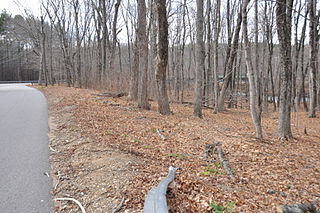
The Fourth Camp of Rochambeau's Army is a historic military camp site near Plains Road and Lovers Lane on the banks of the Shetucket River in Windham, Connecticut. It was here that the French Army encamped in the summer of 1781 under the command of Rochambeau on their march from Providence, Rhode Island to rendezvous with the Continental Army under General George Washington. Four divisions passed through, each one day apart. One of Rochambeau's aides described Windham at the time as "a charming market town, where, incidentally, there were many pretty women at whose homes we passed the afternoon very agreeably." Of the camp site, he wrote, "A mile away is a beautiful river with a fine wooden bridge. We camped on its banks very comfortably, though hardly militarily."

March Route of Rochambeau's Army: Manship Road-Barstow Road is a historic site in Canterbury, Connecticut that was listed on the National Register of Historic Places in 2003, for its evocation of the march route French commander Rochambeau's troops in 1781 and in 1782.

March Route of Rochambeau's Army: Old Canterbury Road is a historic site in Plainfield, Connecticut along the 1781 and/or 1782 march routes of Rochambeau's army. It includes a stretch of what is now Old Canterbury Road and a stretch of Canterbury Road whose environs evoke the period of the Rochambeau army's march. It is a 2-acre (0.81 ha) site that was listed on the National Register of Historic Places in 2003.
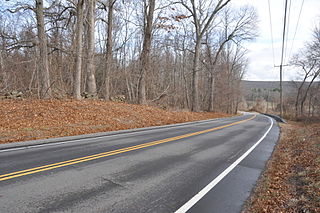
The March Route of Rochambeau's Army: Palmer Road is a linear historic district encompassing a portion of Connecticut Route 14 in eastern Scotland, Connecticut. It was listed on the National Register of Historic Places in 2003 as an evocative surviving element of the march route of the French Army commanded by Rochambeau during the American Revolutionary War in 1781 and 1782.

March Route of Rochambeau's Army: Plainfield Pike is a 3.6 mile-long road segment in Plainfield and Sterling, Connecticut which forms a portion of the historic march route of Comte de Rochambeau's army in June 1781 on its way to Yorktown, Virginia, and again of the returning army in November 1782. It was listed on the National Register of Historic Places (NRHP) in 2003.

The Caleb Baldwin Tavern is a historic house at 32 Main Street in the Newtown Borough Historic District, located in Newtown, Connecticut, United States. Built c. 1763, the two-and-a-half-story house it is considered historically significant for its role in movement of French forces of Rochambeau, in which the building housed some of the army's officers in June 1781, en route to the Siege of Yorktown. It also an example of traditional 18th-century New England architecture, and retains some details from that time period. It was individually listed on the National Register of Historic Places on August 23, 2002.

Camps Nos. 10 and 41 of Rochambeau's Army, also known as Site No. 97-87D, is an historical archeological site that was listed on the National Register of Historic Places in 2002. It encompasses the areas occupied by the French Army of Rochambeau during their marches across Connecticut in 1781 and 1783. One of the major encampment site is located on the grounds of the Hawley School, where a historic marker is placed.

March Route of Rochambeau's Army: Reservoir Road is a historic site in Newtown, Connecticut. It was listed on the National Register of Historic Places in 2003.

The March Route of Rochambeau's Army: Hutchinson Road is a 2-acre (0.81 ha) historic road section in Andover, Connecticut. The section of Hutchinson Road, laid out in the early 18th century and formerly an alignment of United States Route 6, formed part of the 1781-82 march routes of Rochambeau's army which contributed to American victory in the American Revolutionary War. It was listed on the National Register of Historic Places in 2002.

The Fifth Camp of Rochambeau's Infantry, also known as Site 12-25, is a historic site and an archeological site in Bolton, Connecticut, on the march route of Rochambeau's army on its way to the Hudson River and ultimately to Yorktown, Virginia. It was used on four successive nights, the 22nd through the 25th of June, 1781, by the four divisions of Rochambeau's army. In the evenings, the French entertained locals by playing music and dancing with local women, on Bolton Green.

March Route of Rochambeau's Army: Ridgebury Road is a historic site in Ridgefield, Connecticut. It was listed on the National Register of Historic Places in 2003.

The Josiah Bronson House is a historic house on Breakneck Hill Road in Middlebury, Connecticut. Built about 1738, it is one of the town's few surviving 18th-century houses, and a good example of residential architecture from that period. The house was listed on the National Register of Historic Places in 1982.





















